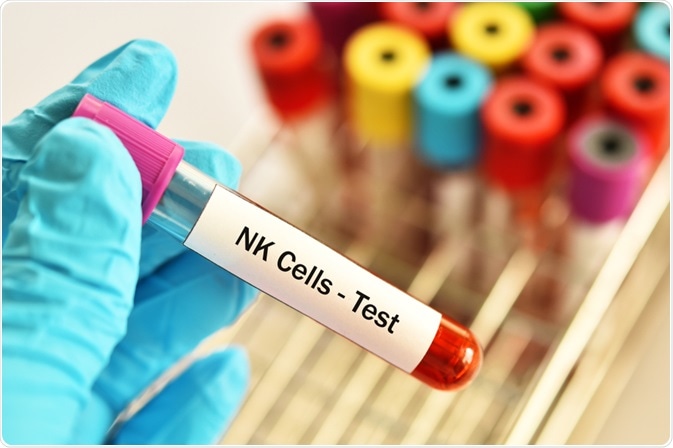Throughout modern history, astronauts in spaceflight have been shown to experience frequent bacterial and viral infections. Flow cytometry has therefore been used in numerous studies to elucidate how specific changes in immune cell populations may be responsible for this immune dysfunction.
 Image Credits: Jarun Ontakrai / Shutterstock.com
Image Credits: Jarun Ontakrai / Shutterstock.com
An overview of flow cytometry
Flow cytometry (FC) is a widely applied analytical technique that utilizes, typically with wavelengths of either 488, 642, 532 or 405 nanometers (nm), lasers to scan and evaluate suspended cells and other particle types. Typically, fluorescent antibodies and/or dyes are used to treat the cell samples and allow for the identification and separation of cells tagged with specific surface proteins, intracellular markers or other cell targets.
When flow cytometry is used for blood analysis, several different staining steps are usually required, which include white blood cell (WBC) segregation, red blood cell (RBC) lysis and sample fixation. Whereas clinical blood analyses will often utilize specialized hematology instruments to acquire complete blood counts (CBC), flow cytometry for cell culture analysis can be used to measure various levels of immune cell function.
How the immune system functions
Any immune response is achieved by the numerous cell types that comprise the immune system that function to protect an organism against potentially harmful pathogens like bacteria and viruses. The first line of defense is provided by both the physical and chemical composition of barriers like the skin and mucus and the enzymes and acidic chemicals that comprise them.
Comparatively, the second line of defense, otherwise referred to as the innate immune system, is made up of immune cells known as phagocytes that are present within various body tissues and primarily function to eliminate pathogenic species from the body.
Immune dysregulation with spaceflight
Since the first Apollo mission in 1969, more than 50% of astronauts embarking on trips to space have suffered from some type of bacterial or viral infection. The myriad of factors contributing to negligent immune responses, which include stress, microgravity and radiation exposure, have been found to contribute to this phenomenon.
Despite its continued recurrence in astronauts, little work has been successful in elucidating the clinical significance of this immune dysregulation.
Monitoring alterations in immune system function
Several different flow cytometry techniques have been used to determine any differences that may exist in the immune cell measurements of astronauts prior, during and immediately following spaceflight. Flow cytometry has been proven to be an ideal analytical technique for these types of studies has a result of its relative ease of operation for knowledgeable users, high reliability and wide range of applicable assays.
One of the most common applications of flow cytometry for such spaceflight studies has involved measuring the distribution of peripheral blood leukocyte cell populations. Typically, such alterations in leukocyte distribution can be clinically significant.
For example, increases in these levels can reflect immune system activation, expansion, and/or proliferation, whereas decreases can reflect immune cell migration out of the blood and/or localization of these cells to specified sites of inflammation.
To date, flow cytometry fluorochromes and channel capabilities of flow cytometry instruments have significantly expanded to include a wide range of immune cell subsets, some of which include granulocytes, lymphocytes, monocytes, cytotoxic effect cells like CD8+ and numerous memory T cell markers such as CD3, CD8, CD45RA, CD62L and CD11a, to name a few.
More recent advancements have allowed researchers to now utilize flow cytometry for the identification of more fine leukocyte subtypes, such as B cells, NK cells and monocytes, each of which are associated with their own clinically significant effects.
Spaceflight applications
Some of the earliest applications of flow cytometry for spaceflight immune monitoring occurred in 1999, when a group of researchers measured changes in the WBC and granulocyte levels of astronauts following the Space Shuttle mission. In their work, astronauts were found to have significantly higher levels of both immune cell populations immediately after landing, which has been postulated to be the result of reentry stress.
Another study on a group of Space Shuttle astronauts was conducted to determine the effects that varying mission durations have on their immune system. In their work, WBC, granulocyte, monocyte, B cell and CD4+ T cells were all found to be significantly elevated postflight, whereas NK cells were found to be lower.
When comparing the effect that different mission durations have on these levels, researchers found that astronauts on 1-week missions exhibited more pronounced changes in their immune cell levels as compared to those on 2-week missions.
Several other studies have also investigated how changes in the levels of intracellular cytokines may be results from spaceflight.
To this end, a 2008 study found that both IFNγ and IL-2 from both CD4+ and CD8+ T cells in Shuttle and ISS astronauts after landing were significantly lower as compared to controls. Another similar study found that the intracellular production of IL-6 and IL-8 in monocytes was reduced postflight, whereas IL-1β and IL-1ra levels were elevated.
Conclusion
Flow cytometry has demonstrated its versatility to monitor and quantify immune dysregulation in astronauts throughout the spaceflight process. By understanding how the immune system responds to spaceflight, national organizations like the National Aeronautics and Space Administration (NASA) within the United States can be more prepared to mitigate clinical risks for astronauts and other crew members during spaceflight.
Sources
- Crucian, B., Makedonas, G., & Sams, C. Chapter 27 Flow Cytometry Methods to Monitor Immune Dysregulation Associated with Spaceflight. In: Stress Challenges and Immunity Space. 2nd ed. Munich, Germany: 2020;499-418. DOI:10.1007/978-3-030-16996-1.
- Crucian, B., Chouker, A. Chapter 11 Immune System in Space: General Introduction and Observations on Stress-Sensitive Regulations. In: Stress Challenges and Immunity Space. 2nd ed. Munich, Germany: 2020;205-220. DOI:10.1007/978-3-030-16996-1.
Further Reading